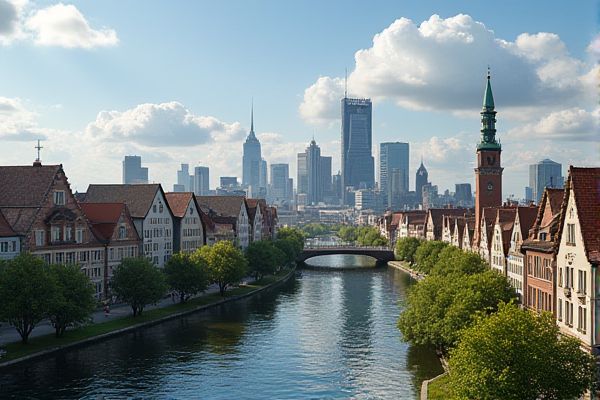
Transportation and commuting in Germany: Extensive public transportation network. Punctual trains and buses. Regional transport passes available. Efficient S-Bahn and U-Bahn systems. Affordable monthly commuter cards. Comprehensive bike lanes and paths. Car-sharing programs popularity. Low-emission zones in cities. Ride-sharing apps widely used. Well-maintained highways (Autobahn).
Extensive public transportation network
Germany boasts an extensive and efficient public transportation network, including high-speed trains, regional and urban trains, buses, trams, and metro systems. These are managed by both national and local authorities, ensuring comprehensive coverage and ease of use for commuters and travelers alike. To explore more about the convenience and structure of these systems, you can visit the detailed guide on Public Transportation in Germany and discover how it supports seamless travel across the country.
Punctual trains and buses
In September 2024, approximately 89% of Deutsche Bahn's passenger trains arrived with a delay of no more than 5:59 minutes. However, the punctuality of long-distance trains was significantly lower in November 2023, with only 52% of ICE and IC trains reaching their destinations on time. This decrease in punctuality was primarily due to construction and renovation issues. For more detailed statistics and insights, visit the Statista website.
Regional transport passes available
The Deutschland-Ticket is a regional transport pass that allows unlimited use of all local and regional public transport in Germany, including buses, trams, city trains, suburban trains, and regional trains, for a monthly fee of 49 euros. This fee will increase to 58 euros from January 2025. However, it is important to note that it is not valid on long-distance services like ICE, IC, or EC trains, or on privately operated services. For more details, you can visit the Deutschland-Ticket website.
Efficient S-Bahn and U-Bahn systems
Germany's S-Bahn and U-Bahn systems are highly efficient and integral to the country's public transportation network. The S-Bahn, or city rapid rail, connects suburbs and urban areas with frequent and punctual services, while the U-Bahn, or subway, operates extensively in major cities like Berlin, Munich, and Hamburg, offering high speed and modern amenities due to dedicated tracks and advanced infrastructure. For more detailed insights into these systems, you can explore further on the Transportation System In Germany, which highlights the impressive organization and effectiveness of these networks.
Affordable monthly commuter cards
The Deutschland-Ticket, or "D-Ticket," provides unlimited travel on local public transport such as buses, U-Bahns, S-Bahns, trams, and local and regional trains, for an economical rate of 49 euros per month until December 2024. Starting January 2025, the fare will be adjusted to 58 euros per month. This pricing model ensures that commuting and travel across Germany remain highly affordable for residents and visitors alike. For further details, you can visit the Deutschland-Ticket website, which outlines the terms and benefits of this comprehensive transport pass.
Comprehensive bike lanes and paths
Germany's comprehensive bike lane network, known as the Radnetz Deutschland, consists of twelve long-distance cycle routes and the 'German Unity Cycle Route', connecting all regions of Germany with signposted bike networks and routes like the North Sea Cycle Route, Weser Cycle Route, and Elbe Cycle Route, ensuring safe and convenient cycling across various landscapes. Meanwhile, the National Cycling Plan 3.0 aims to enhance cycling infrastructure, making cycling more attractive and safer by 2030. This plan focuses on seamless cycling networks and high-quality infrastructure, with joint efforts from federal, state, and local authorities to promote cycling nationwide. Additionally, it includes funding for cycle paths along federal highways and supports the development of safe and modern cycling facilities.
Car-sharing programs popularity
Car sharing in Germany has seen significant growth, with registered user numbers increasing from over one million in 2015 to more than 5 million in 2024, driven by financial and sustainability reasons, particularly in urban areas where public transport is prevalent but occasional car use is necessary. For more in-depth information and statistics, you can visit the Car Sharing Industry in Germany page on Statista's website.
Low-emission zones in cities
In Germany, Low-Emission Zones (Umweltzone) have been established in over 70 cities to improve air quality. These zones require vehicles to have an emissions sticker (Umweltplakette) to enter. Each sticker's color indicates the vehicle's pollutant class, with some cities even implementing diesel bans to further reduce emissions. To learn more about the specific requirements and locations of these zones, visit the German Emissions Sticker website.
Ride-sharing apps widely used
In Germany, the most widely used ride-sharing apps include Uber, BlaBlaCar, FreeNow, Fahrgemeinschaft, and Bolt. These apps offer convenient, efficient, and often sustainable travel options, with features such as easy booking, real-time tracking, and various vehicle options, aligning with Germany's focus on reducing traffic congestion and environmental impact. For more detailed insights on these services, you can explore the Best Ride-Hailing And Taxi Apps In Germany article, which discusses how these innovations are transforming urban mobility.
Well-maintained highways (Autobahn)
Germany's Autobahn is a well-maintained, extensive network of federal controlled-access highways, spanning approximately 13,192 kilometers, making it one of the longest and densest highway systems in the world. The Autobahn is known for its high construction standards, multiple lanes in each direction, and the absence of blanket speed limits on many sections, although advisory and specific speed limits are imposed in certain areas.
